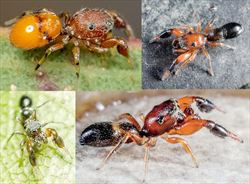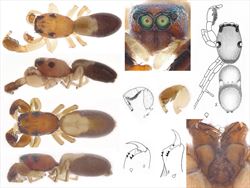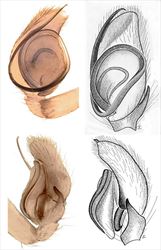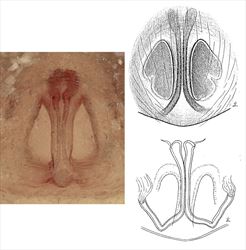
Examples of live Rhombonotus
Illustrators (and ©) I.R. Macaulay, R. Whyte (BL)

Aspects of the general morphology of Rhombonotus
Illustrators (and ©) B.J. Richardson (CSIRO), M. Zabka (diag,) (QMB)

Palp morphology of Rhombonotus
Illustrators (and ©) B.J. Richardson (CSIRO) M. Zabka (diag.) (QMB)

Epigyne morphology of Rhombonotus
Illustrators (and ©) B.J. Richardson (CSIRO) M. Zabka (diag.) (QMB)
Rhombonotus L. Koch, 1879
Taxonomy
Rhombonotus has one Australian species, Rhombonotus gracilis. Other species have been discovered and documented but not yet named (Whyte and Anderson, 2017). In Australia the genus is related to other ant-mimicking genera, Damoetas, Judalana, Ligonipes and Myrmarachne and elsewhere to Belippo (Africa) and Bocus (Borneo and the Philippines) (Maddison, 2015). Rhombonotus, along with Judalana and Ligonipes, has a strong, thick fringe of black hairs on the tibia of the first leg. Further information on the genus and described species can be found in Richardson and Żabka (2017) and Whyte and Anderson (2017).
Description
Rhombonotus gracilis is a mostly small to medium-sized spider, ranging in body length from 3 to 4 mm. The head, viewed from above, is rather rhomboid in shape, widest behind the posterior lateral eyes which overlap the edges of the cephalothorax. The dorsal surface of the carapace is somewhat stippled or frosted. In profile the carapace appears flattened and this extends till well past the posterior lateral eyes before sharply descending. The median posterior eye is closer to the anterior lateral eye than the posterior lateral eye (unlike in Ligonipes). The abdomen is elongate with a waist a third of the way from the front. Chelicerae in the male have three retromarginal teeth (plurident) and three separate promarginal teeth while the female has two separate retromarginal and two promarginal teeth. Unlike Judalana, there are no mastidions (‘horns’) on the anterior face of the male paturon. The first pair of legs is much stouter and stronger than the others, with a swollen and strongly fringed tibia in the male.
The male’s palp has a long embolus winding clockwise around the tegulum which is rounded with a small proximal lobe. The tibia of the palp has a single, short, sharp apophysis.
The female has two large, well-delineated epigynal atria. The laterally-located copulatory openings are outside each atrium, open into insemination ducts which travel medio-posteriorly around the atria and then turn sharply to travel anteriorly along the midline, ending well beyond the atria. The ducts and spermathecae form a simple continuous tube.
Biology
This ant mimic is found in a wide range of habitats ranging from woodland and dry forest to rainforest. It has been collected from foliage, tree trunks and on the ground.
Distribution
Rhombonotus occurs widely across Australia in all States and Territories, including Tasmania.
References
Davies, V.T. & Żabka, M. 1989, Illustrated keys to the genera of jumping spiders (Araneae: Salticidae) in Australia. Memoirs of the Queensland Museum 27, 189-266.
Maddison, W.P. 2015. A phylogenetic classification of jumping spiders (Araneae: Salticidae). Journal of Arachnology 43, 231-292.
Richardson, B.J. & Żabka, M. 2017. Salticidae. Arachnida: Araneomorphae. Canberra, Australian Faunal Directory. Australian Biological Resources Study, at https://biodiversity.org.au/afd/taxa/SALTICIDAE.
Whyte, R. and Anderson, G. 2017. A field guide to the spiders of Australia. Clayton: CSIRO Publishing 451pp.
* The information sheet should be interpreted in the context of the associated diagrams and photographs. Diagrams explaining anatomical terms can be found in the ‘Salticidae’ pictures at the beginning of the list of genera.